Deep fried pork ribs come in different flavors and cooking styles. The best one is called ‘pork ribs king’ (排骨王), popular in Chinese restaurants in Singapore and Malaysia.
The pork ribs are marinated, deep-fried, and doused in a sweet and sour sauce. It tastes heavenly when serving immediately while still crispy on the outside and indeed worthy for that title.
My initial thought was that it involves a complicated cooking process, but I realized that it is pretty easy to prepare.
The secret lies in the sweet and sour sauce, with Worcestershire sauce is one of the components. Another crucial step is to marinate it overnight to let the flavor penetrate down to the bone.
In this article, I will explain how to prepare this evergreen dish popular at the local restaurants.
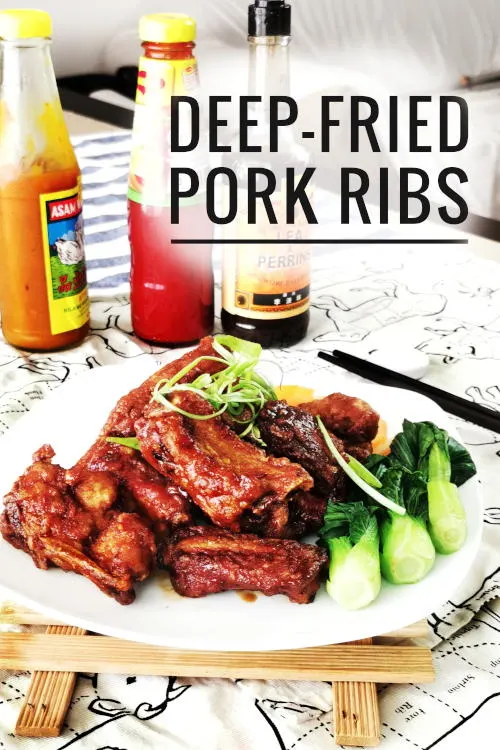
Note: This post may contain affiliate links. Please read my privacy policy for more info. I may receive commissions for purchases made through links in this post. As an Amazon Associate, I earn from qualifying purchases.
Kyoto pork ribs, a.k.a. Pork ribs king
This deep-fried pork rib was created by Master Chef Hooi Kok Wai in the 1960s when he started his new restaurant in Singapore. Back then, it was called Japanese pork ribs since he got the inspiration from tonkatsu. Subsequently, the name has changed to Kyoto pork ribs (京都排骨). The taste is so good that it was widely praised as the king of pork rib (排骨王) by the locals. You can read more about his restaurant here for more details.
How to make deep-fried pork ribs, a.k.a Kyoto pork ribs/pork ribs king
The pork ribs should be marinated in advance, preferably overnight, to let the marinade penetrate down to the bone.
1. Use pork loin as the alternative
Besides pork ribs, some restaurants used sliced pork loin in place of pork ribs to prepare this dish. If you intend to do that, please use a meat mallet or the spine of the cleaver to pound the pork loin. This method helps to tenderize the pork loin, which is tougher than the ribs.
Some restaurants also use a unique cut consisting of a small part of the rib links to the loin. While this cut can be difficult to get, the typical pork ribs will give you the same texture and taste.
If you do not eat pork, this recipe also goes well with chicken.
2. The marinade for the pork ribs
Although I mix the pork ribs with the sweet and sour sauce later, they still need to marinate to get the best result. The marinade is a mix of ingredients different from the sauce, which adds flavor absent in the sauce to the pork ribs.
The pork ribs are marinated with oyster sauce, salt, sugar, sesame oil, ground white pepper.
Apart from the ingredients above, a quarter teaspoon of baking soda helps to tenderize the meat, and a tablespoon of all-purpose flour will bind the liquid seasoning to the pork ribs.
After cleaning the pork ribs, make sure to keep them very dry since it is difficult to deep-fry them until crispy if there is too wet.
Massage the marinade into the pork ribs and store it in the refrigerator overnight.
3. Made the sauce for the deep-fried pork ribs
Next, prepare the sauce to coat the deep-fried pork ribs.
The components of the sweet and sour sauce
- Chinese rice vinegar is the main component, and therefore do not use other types of vinegar if you want to get the best result. I use red vinegar 浙醋, which is light red due to the inclusion of red yeast rice in production. You may also use the black vinegar called Chinkiang vinegar, 镇江香醋.
- Worcestershire sauce is the component that provides the savory flavor. Although it is not a typical component of traditional Chinese food, it is increasingly being used as its taste complements most Chinese cooking ingredients.
- Tomato ketchup is also required in another sweet and sour sauce recipe that I wrote. You can substitute it with tomato paste.
- Plum sauce is a viscous, light brown sauce made with sweet plums, sugar, vinegar, and salt. It is the basis of a few variations of Chinese sweet and sour sauces.
- Besides that, it also required some sugar (to taste) and five-spice powder. This spice mix consists of star anise, fennel, peppercorns, cinnamon, and cloves, regularly used to season different Chinese food.
Make a large batch to save time
Since the sauce is versatile for cooking dishes apart from the pork ribs, it is worth making a large batch, then portion in small freezer-safe containers and keep for future use. You can freeze the sauce for up to two to three months without any noticeable change of flavor.
To prepare the sauce, measure all the ingredients in a small pot, then bring it to a boil to dissolve the sugar. I portioned 100g of the sauce in small freezer-safe containers, which is the ideal amount to cook half kg / one pound of pork ribs or meat.
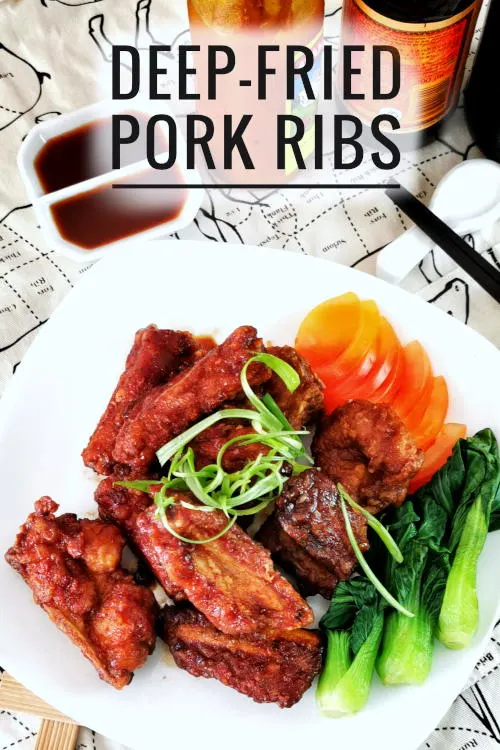
4. Deep-fry the pork ribs twice
The next day, remove the marinated pork ribs from the refrigerator and wait until they return to room temperature before deep-frying. If you deep-fried them while still cold, the meat might not be fully cooked when the exterior has turned golden.
Coat the pork ribs with some cornstarch before deep-frying. Alternatively, you can use potato starch or tapioca starch to replace cornstarch. After that, let it rest for at least five minutes before deep-frying so that the moisture from the pork ribs and the marinade absorb the cornstarch, which will adhere firmly to the pork ribs. The cornstarch would fall off from the pork ribs if you deep-fried it immediately without resting. Alternatively, you can coat the pork ribs with egg before rolling them in the bed of cornstarch, but it is not necessary if you rest them for five minutes.
Here is how to deep-fried the pork ribs until crispy:
- Heat about half an inch deep of vegetable oil in a pan to 150°C/300°F. You can check it with a kitchen thermometer or dip a pair of wooden chopsticks into the oil. The oil’s temperature is right when there are streams of bubbles rising slowly around the chopsticks.
- Place the coated pork ribs into the oil gently. Do not crowd the pork ribs to let them have sufficient space in between as they might stick together if it is too crowded.
- Let the pork ribs undisturbed for three minutes, then flip over to deep-fried the other side. Pay attention to the color of the surface and remove them once they turn light golden.
- Drain the pork ribs in a colander.
- Raise the temperature of the oil to 200°C/390°F. There will be a stream of bubbles rising vigorously around the chopsticks at this temperature.
- Return the pork ribs to the oil to deep-fry for the second time.
- The second round of deep-frying will dry up the pork ribs’ exterior rapidly to yield a crispy texture that lasts. Since the color changes quickly at a high temperature, you need to observe the color closely to avoid being overcooked. Once they turn golden brown, remove them immediately and drain them in a colander.
5. Douse in the sweet and sour sauce
To serve, simply douse the deep-fried pork ribs in the heated sweet and sour sauce. I like to add a tablespoon of Shaoxing wine to the sauce before mixing with the pork ribs, adding more flavor and aroma to the final result.
The pork ribs are best to serve it immediately after cooking while crackling on the exterior. However, it remains incredibly deciduous after half a day due to the deep savory flavor.
Summary
In summary, there are three crucial points to make the top-quality pork rib king (Kyoto pork rib).
- Marinate the pork ribs overnight. Trust me, and it makes a huge difference compared to those which marinate for only one to two hours.
- Deep-fry the pork ribs twice. This step is crucial to make it crispy even after dousing in the sweet and sour sauce.
- Use a good quality sweet and sour sauce. Of course, you may want to make some changes (sweetness, sourness e.t.c.), but the composition of the sauce in this recipe serves as an excellent starting point to make any modification.
Other similar recipes you may want to try.
If you like this recipe, you will likely want to try some similar recipes on this blog. Here are my picks.
Bak Kut Teh is a popular meat dish in Malaysia and Singapore. It is a meat and pork rib dish cooked in a broth flavored with various Chinese medicinal herbs.
Wuxi Pork rib is so tender that the meat is almost melting off from the bone! It also involves rice vinegar and Shaoxing like the deep-fried pork ribs but is prepared with prolonged braising. You will be rewarded with the seductive flavor of this culinary wonder.
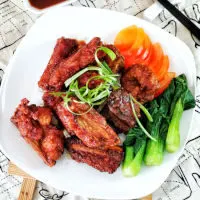
Deep fried pork ribs - so good that it fits the title as king of pork ribs
This deep fried pork rib fit the title as the king of pork ribs. It is crispy outside, with an intense sweet and sour flavor, and deep fried to perfection. The locals crown it as pork rib king.
Ingredients
Ingredients A (marinate the pork ribs)
- 750g pork ribs
- 1 tbsp oyster sauce
- 1 tsp salt
- 1 tsp sugar
- 1 tsp sesame oil
- ½ tsp white pepper powder
- ½ tsp baking soda
- 1 tbsp all-purpose flour
Ingredients B (others)
- Cornstarch to coat the pork ribs
- Oil for deep-frying
- Sweet and sour sauce 150g (refer to note section)
- 1 tbsp Shaoxing wine
Instructions
- Marinade the pork ribs with ingredients A overnight.
- Remove the marinated pork ribs from the fridge and wait until they are back at room temperature.
- Coat the pork ribs with cornstarch. Shake off the excess cornstarch.
- Deep-fry the pork ribs at 150°C/300°F until lightly golden. Drain and rest for five minutes.
- Deep-fry the pork ribs for the second time at 200°C/390°F until golden brown. Drained.
- Bring the sweet and sour sauce to a boil.
- Add a tablespoon of Shaoxing wine to the sauce.
- Return the deep-fried pork ribs to the wok, then coat them with the sauce.
- Dish out and serve.
Notes
The sweet and sour sauce recipe:
Ingredients:
- 100ml Chinese rice vinegar
- 30ml Worcestershire sauce
- 75ml tomato ketchup
- 75ml Chinese plum sauce
- 30g sugar
- 1 tsp Chinese five-spice powder
- 100ml water
Method:
- Combine all the ingredients in a pot.
- Bring the ingredients to a boil, let it cools.
- Transfer to freezer-safe containers.
- Store in the freezer for future use.
Note:
- This amount is enough for 2kg of pork ribs. You can keep some for future use. Otherwise, reduce the amount to 1/3 for 750g of pork ribs as in this recipe.
- If you portion the sauce in100ml containers, it is enough to cook 500g/lb of meat of ribs.
Recommended Products
As an Amazon Associate and member of other affiliate programs, I earn from qualifying purchases.
Nutrition Information:
Yield: 3 Serving Size: 1Amount Per Serving: Calories: 1260Total Fat: 87gSaturated Fat: 25gTrans Fat: 1gUnsaturated Fat: 41gCholesterol: 275mgSodium: 1576mgCarbohydrates: 63gFiber: 1gSugar: 11gProtein: 55g
This data was provided and calculated by Nutritionix on 8/7/2021

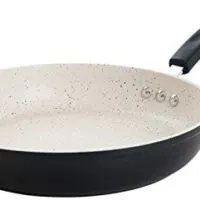
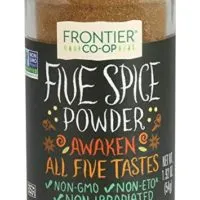

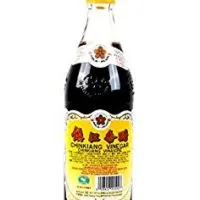
Tommy
Sunday 1st of January 2023
Just made it and it tasted wonderfully yummy!
Allan
Monday 9th of August 2021
Dear KP. Hi new to your site. Love the fried rib recipe. Can I boil them first to soften and clean then marinate them overnight?
KP Kwan
Monday 9th of August 2021
You can blanch the ribs in boiling for a minute to remove any blood and impurities, wipe it dry and then combine with the marinade. It helps to remove the porky smell.
KP Kwan
Saturday 7th of August 2021
Hi, this is KP Kwan. I am happy to see you in this comment area, as you have read through my recipe. I am happy to reply to any questions and comments as soon as possible.